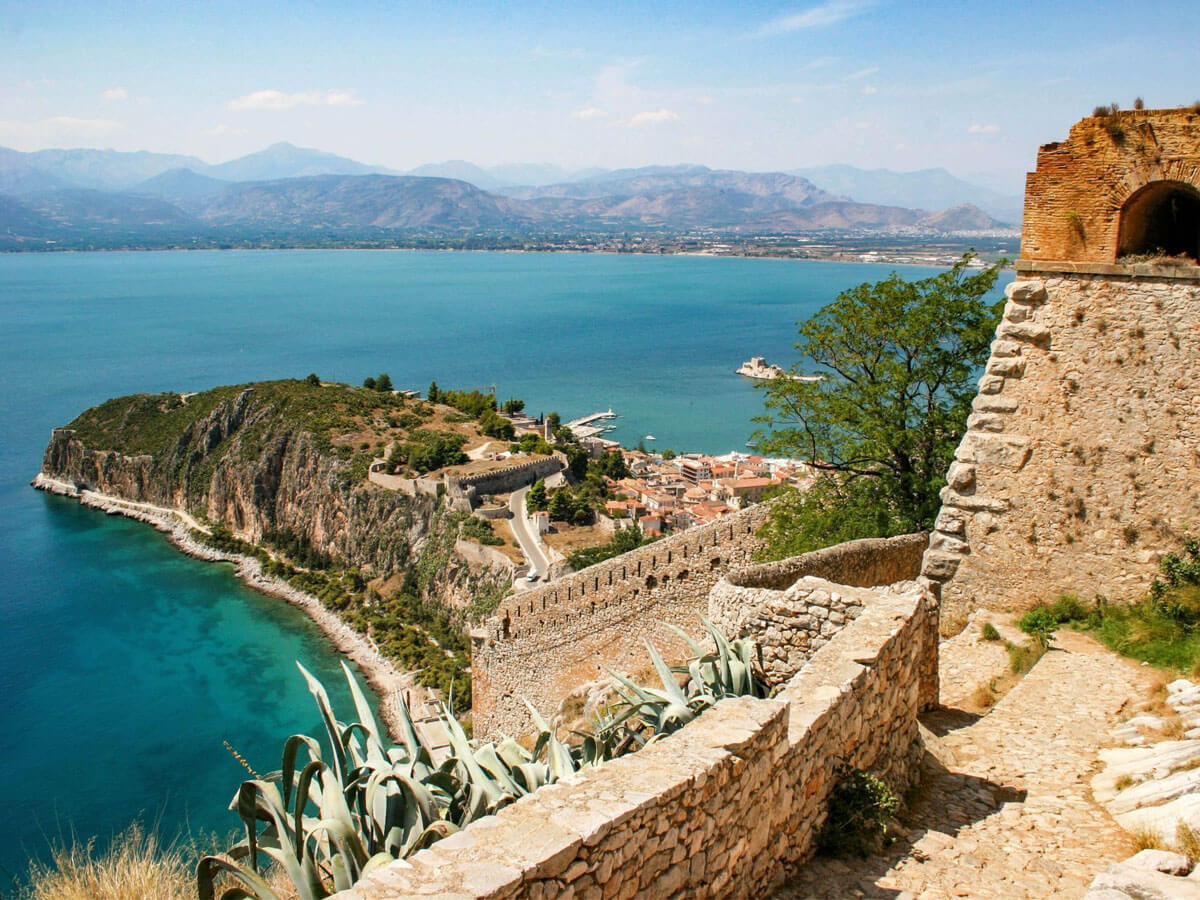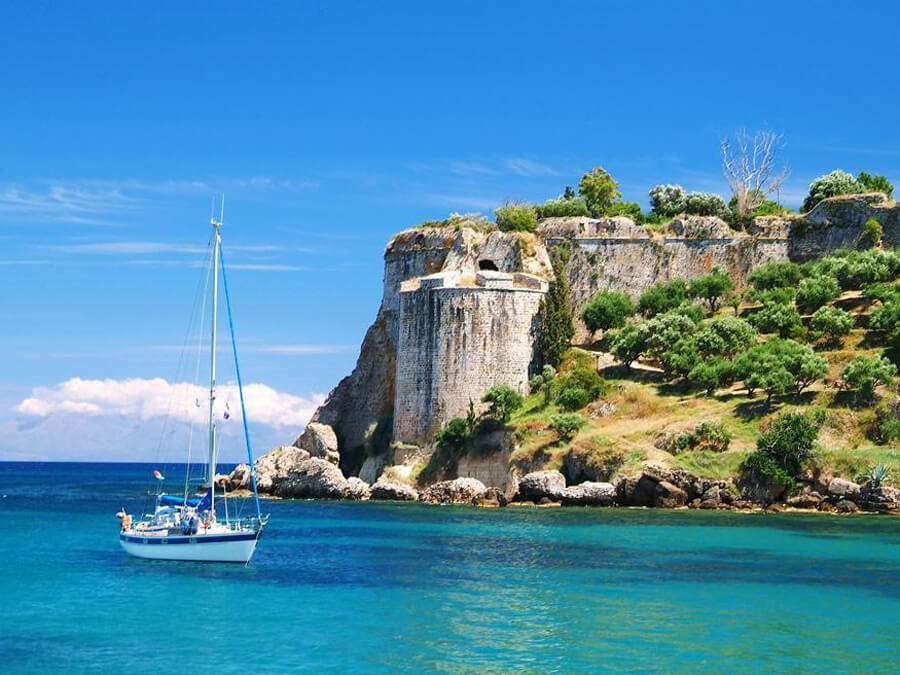1. Castle of Akrocorinth
The largest castle in the Peloponnese is, as the legend goes, the work of Sisyphus, the ancient king of Corinth. As the myth goes, Sisyphus’ eyes once caught Zeus and Aegina fooling around in a way that the beautiful girl's father would not approve of. And her father was not just anyone, he was the river god Asopos. So Sisyphus did not waste any moment, he went to the worried father and promised to tell him where Zeus was ‘fooling around' with his daughter, on one condition: He needed a constant source of fresh water on his castle.
And from that time on, the Acrocorinth became a large and mighty castle city. During history, the castle changed so many hands that today it is very difficult to classify it in a specific period; some say that this is an ancient castle, some say Byzantine, Venetian, or Ottoman. Nonetheless, it is a beautiful castle with a compelling story!
![Credit: Elveoflight, <a target='_blank' href='http://creativecommons.org/licenses/by-sa/3.0/'>[CC BY-SA 3.0 via Wikimedia Commons]</a> The Castle of Akrocorinth](/images/Blog/Peloponnese%20Castles/Akrocorinth-castle-in-Peloponnese.jpg)
2. Castle of Monemvasia
This mesmerizing castle is, without a doubt, one of the most beautiful castles in the world. It was built in 583, during the reign of Byzantine Emperor Mauricius. It was quickly evolved into a very important stronghold and shelter during raids. During the centuries, it changed many hands. Today, it is one of the best destinations in the Peloponnese, especially during Easter. Once in Peloponnese, this should definitely be one of your destinations.

3. Castle of Rio
The Castle of Rio belonged to a very powerful Ottoman, Suleiman's grandfather, and it was built in 1499. The "Kastelli of Moria", as it is also known, together with the “Kastelli of Roumeli” in Antirrio, are today the best-preserved Ottoman castles in Greece. The Castle of Rio is protected by the sea from three sides (even its moat is still filled with seawater). It has two gates, one on land and one on the sea, and together with the Castle of Antirrio, it was blocking the entrance so well that the Ottomans used to say that "not a single bird flies among them". The Castle of Rio is visitable and it is located right next to the great bridge of Rio-Antirio, just a few hours away from the cosmopolitan city of the Peloponnese, Patras.
![Credit: Tony Esopi <a target='_blank' href='http://creativecommons.org/licenses/by-sa/3.0/'>[CC BY-SA 3.0 via Wikimedia Commons]</a> The walls of Rio’s Castle](/images/Blog/Peloponnese%20Castles/Rio-Castle-in-Peloponnese.jpg)
4. Niokastro (Castle of Pylos)
Niokastro (or ‘Newcastle’ in a literal translation) was built by the Ottomans during their occupation of the region. The Ottomans, as the legend goes, had a fleet that had never lost a battle since the founding of their empire in 1299. But, because no one can stay undefeated forever, at some point in 1571 they did not just lose, but they suffered an utter disaster in the Battle of Nafpaktos. Two years later, they built the Castle of Pylos in the Peloponnese as a stronghold, to avoid any future disasters. Today, Niokastro is one of the most beautiful castles in Greece. It now houses the Archaeological Museum of Pylos, as well as several buildings that have either been restored or saved in good condition.

5. Palamidi fortress
As the myth goes, Palamides was a warrior who fought in the Trojan War, but he never came back home. He was accused by Odysseus (Ulysses) of treason and was murdered. To take revenge, his father, Nafplios, sent his remaining sons to seduce the wives of the Greek leaders. All succumbed except Penelope, Odysseus’s patient wife.
The Palamidi fortress was completed in 1714 and it is one of the most beautiful castles of Greece, as well as the biggest and most well-preserved fortress of the Venetian rule. It has a rich history and a very important role during the Greek revolution against the Ottomans. When you visit, try to climb all 999 steps to reach its top and admire the magnificent view from the top, with the whole town of Nafplion below and the Bourtzi Castle in the sea.

6. Castle of Koroni
One of the most elegant examples of a Venetian fortress and one of the few castles which houses and temples are still preserved inside, the castle of Koroni dominates almost the entire cape of Akrita in the Peloponnese, at the southern end of the Messinian Gulf. It was built by the Venetians in the 13th century and was strengthened by the Ottomans in the 16th century. The picturesque uphill route, which starts from the pier, takes us back centuries as we meet parts of both the pre-existing Byzantine castle and the ancient fortification.
The narrow cobbled streets lead us to the main gate of the castle, on the north side. Here, the whole settlement was concentrated in its attempt to protect itself from the invasions of the conquerors and of course, pirates! Today, however, few houses are inhabited. Inside the castle, there are carved tombs, underground vaulted tanks made of chipped boulders to collect rainwater, the octagonal tower - a sample of Ottoman architecture - the churches of Hagia Sophia (Byzantine church of the 12th century) as well as the monastery of Ioannis Prodromos. When you visit, make sure to stop at the plateau of the castle to admire the stunning view!

7. Castle of Methoni
Built by the Venetians in the early 13th century on a rocky peninsula, the huge castle, one of the largest in the Mediterranean, occupies the entire area of the cape on the west coast. Its three sides are bathed by the sea while the north, which faces the land, is strongly fortified by a citadel. The entrance is impressive! It is a stone arch bridge with 14 arches - built by the Venetians where one older, wooden, used to exist - to connect the castle to the mainland.
![Credit: Ronny Siegel <a target='_blank' href='https://creativecommons.org/licenses/by/3.0'>[CC BY 3.0 via Wikimedia Commons]</a> The castle of Methoni](/images/Blog/Peloponnese%20Castles/Methoni-Castle-in-Peloponnese-Greece.jpg)
The imposing gate of the castle, decorated with reliefs, is the most imposing point. The built-in lion of St. Mark, a symbol of Venice, definitely stands out. Coats of arms, inscriptions, ruins of houses of Venetian lords, remains of two Ottoman baths, parts of the Byzantine church of Hagia Sophia, the chapel of Agia Sotira (built in 1830 from the French Liberation) are just a few of the castle's attractions.
From the restored Sea Gate begins a paved road that leads to the fortified island of Bourtzi, at the southern end of the castle. The octagonal two-story building was built by the Venetians in 1500, as a bastion to protect the port. During the Ottoman occupation, it functioned as a prison and place of executions. In fact, the locals claim that when the wind blows, the cries of the prisoners reach the ears of the inhabitants even today... The most beautiful time to enjoy the stunning view of the castle is during the sunset when the sun illuminates the massive walls and the Ionian sea. A truly mesmerizing view and a majestic castle in the Peloponnese!
![Credit: Rauenstein <a target='_blank' href='https://creativecommons.org/licenses/by-sa/3.0'>[CC BY-SA 3.0 via Wikimedia Commons]</a> The Bourtzi in the Castle of Methoni in Peloponnese](/images/Blog/Peloponnese%20Castles/Castle-of-Methoni.jpg)
See also:
About the author: Our team at Greek TravelTellers consists of academics and lovers of Greek culture. Our vision is to convey our knowledge and Greek values through unique tours and experiences. Through our blog, we hope to bring Greek history and culture closer to you. Feel free to learn more about us.




